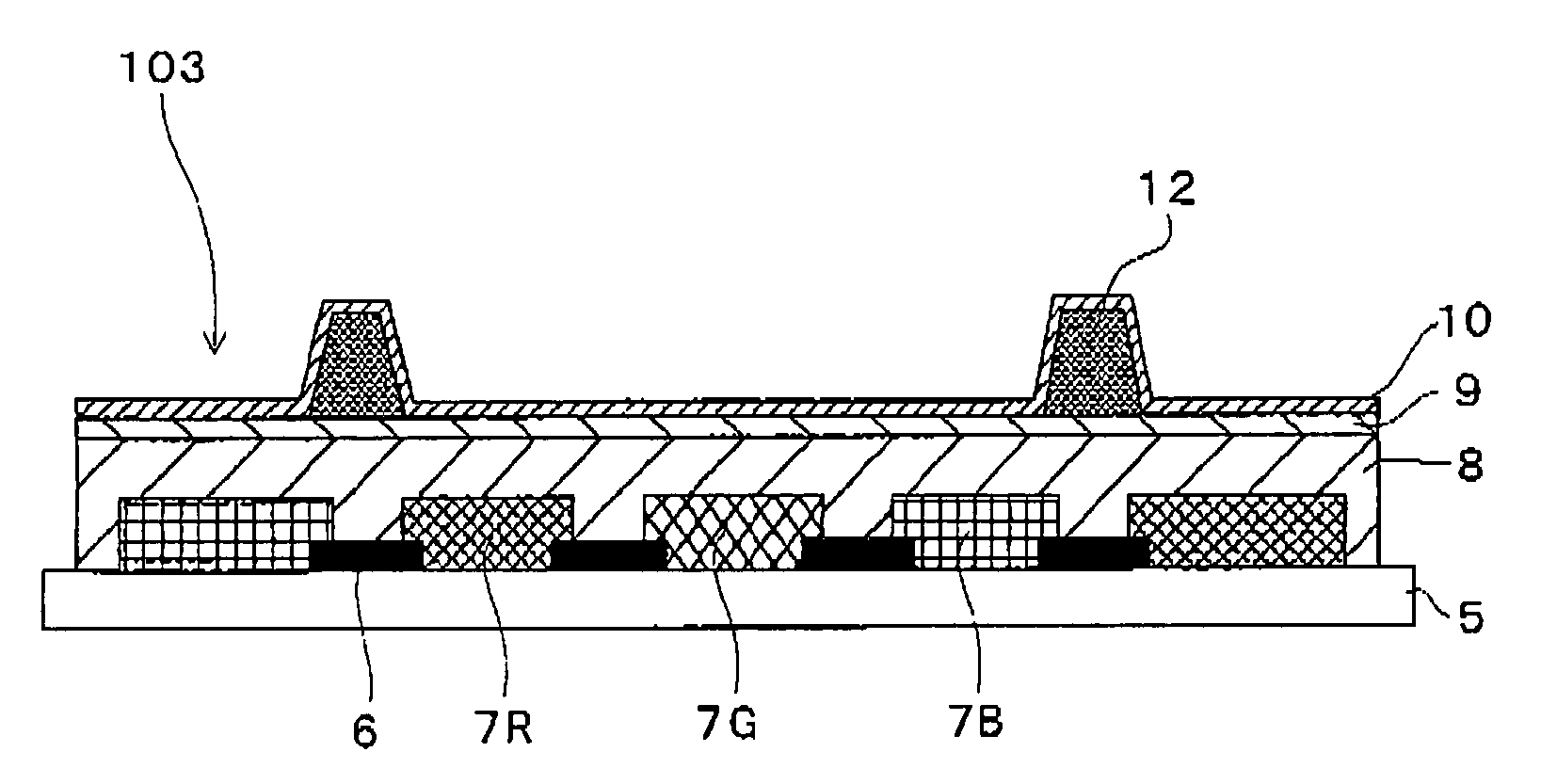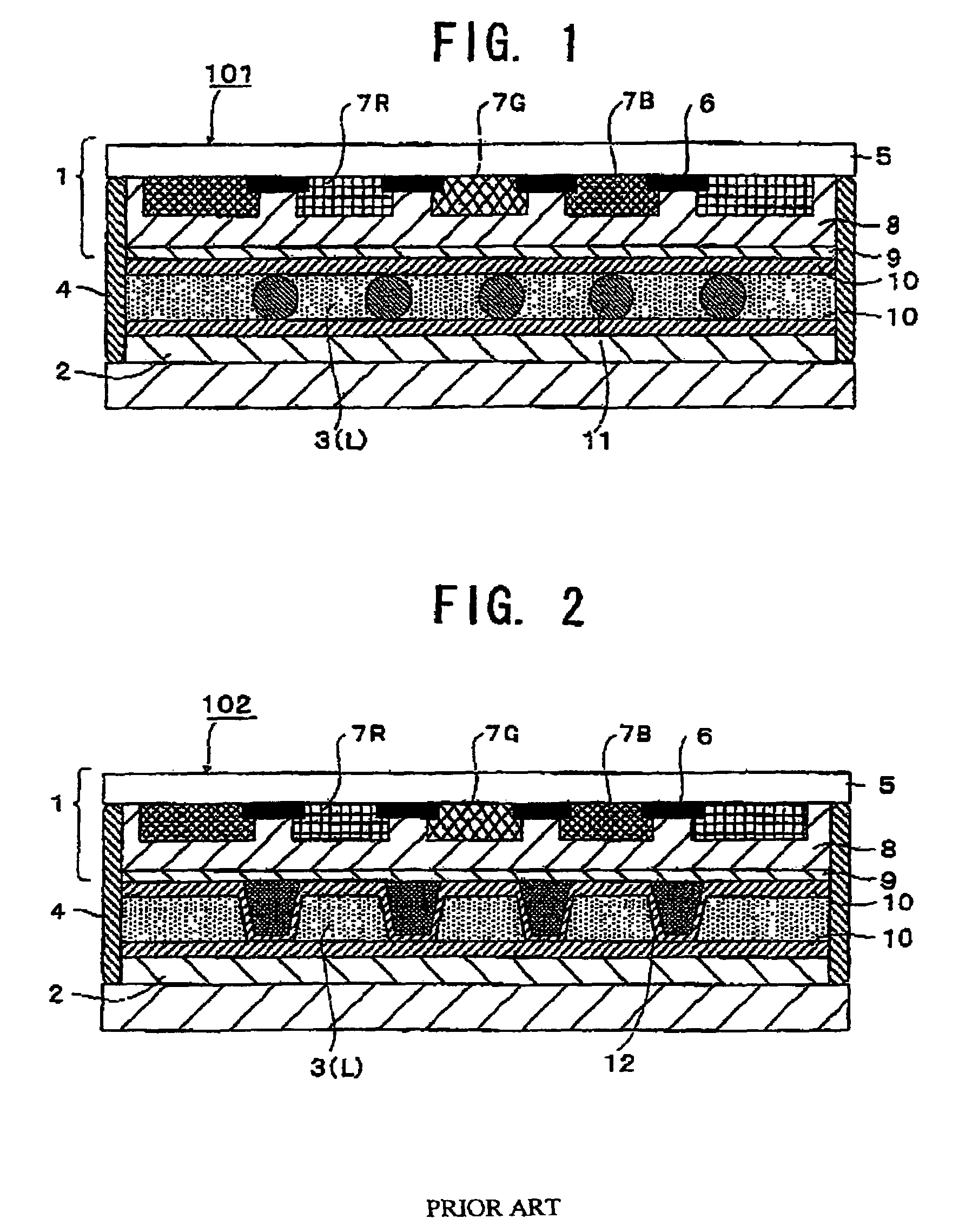Curable resin composition, photosensitive pattern-forming curable resin composition, color filter, substrate for liquid crystalline panel, and liquid crystalline panel
a curable resin and photosensitive technology, applied in the direction of photomechanical equipment, instruments, photosensitive materials, etc., can solve the problems of deteriorating display image quality, difficult to smoothly fill the gap of liquid crystal, and deteriorating image quality, etc., to achieve accurate and precise pattern, high exposure sensitivity, and good developing property
- Summary
- Abstract
- Description
- Claims
- Application Information
AI Technical Summary
Benefits of technology
Problems solved by technology
Method used
Image
Examples
examples a1-a2
, Comparative Examples A1-A3
[0278]Resin compositions for protective layers were prepared as Example A1 and Comparative Example A1, and resin compositions for column-shaped spacers were prepared as Example A2 and Comparative Examples A2 and A3, in which polymer, monomer, additive, initiator and solvent were mixed at respective ratios shown in Table A1.
[0279]
TABLE A1ComparativeExampleExampleCompound or Product nameA1A2A1A2A3PolymerPolymer A1 of25.738.625.751.459.1Production Example A1(Solid Content 35%)PhotocurableSR399E *1001522.522.5CompoundAcidicTO1382 *21522.5000PolyfunctionalPhotocurableCompoundEpoxy ResinEpikote 180S70 *330300PolymerizationIRGACURE907 *41.501.500Initiator2,2′-Bis(o-chlorophenyl)-4,5,4′-1.501.500tetraphenyl-1,2′-bisimidazole *5IRGACURE369 *60904.51.8SolventPropylene glycol monomethylether53.329.953.321.616.6acetateTotal (wt %)100100100100100*1 Nippon Kayaku Co., Ltd.*2 TOAGOSEI Co., Ltd.*3 Japan Epoxy Resins Co., Ltd.*4 Ciba Specialty Chemicals*5 KUROGANE KASEI C...
example a3
Fabrication of Liquid Crystal Panel Substrate
(1) Formation of Black Matrix
[0292]A resin composition for black matrix as shown in Table A3 was applied onto a glass substrate having a thickness of 1.1 mm (AL grade available from ASAHI GLASS CO., LTD.) by using a spin coater and then dried at 100° C. for 3 minutes to form a light blocking layer having a film thickness of about 1 μm. The light blocking layer was exposed in a light blocking pattern with a super high pressure mercury lamp, and then developed with 0.05% potassium hydroxide aqueous solution. Thereafter, the substrate was left in an atmosphere at 180° C. for 30 minutes, so that the substrate was subjected to a heat treatment so as to form the black matrix in a region where the light blocking layer should be formed,
[0293]
TABLE A3Compound or Product nameManufacturer or DistributorBlack pigmentTM black #9550Dainichiseika Color &14Chemicals Mfg, Co., Ltd.DispersingDisperbyk111BYK-Chemie Japan KK1.2AgentPolymerVR60SHOWA HIGHPOLYM...
example a4
Fabrication of Liquid Crystal Panel
[0305]A transparent electrode film was formed on a surface including fixed spacers of the color filter obtained in Example A3, by a DC magnetron sputtering method under the condition that the substrate temperature was 200° C., the discharge gas was argon and oxygen, and the target was ITO. Thereafter, an alignment film was also formed on the transparent electrode film.
[0306]Then, the color filter was aligned (bonded) with the glass substrate on which the TFT has been formed by using an epoxy resin as a sealant, under pressure of 0.3 kg / cm2 at 150° C., to form a cell. TN liquid crystal was filled and sealed in the cell. Thus, the liquid crystal panel of the present invention was fabricated.
PUM
| Property | Measurement | Unit |
|---|---|---|
| boiling point | aaaaa | aaaaa |
| boiling point | aaaaa | aaaaa |
| temperature | aaaaa | aaaaa |
Abstract
Description
Claims
Application Information
 Login to View More
Login to View More - R&D
- Intellectual Property
- Life Sciences
- Materials
- Tech Scout
- Unparalleled Data Quality
- Higher Quality Content
- 60% Fewer Hallucinations
Browse by: Latest US Patents, China's latest patents, Technical Efficacy Thesaurus, Application Domain, Technology Topic, Popular Technical Reports.
© 2025 PatSnap. All rights reserved.Legal|Privacy policy|Modern Slavery Act Transparency Statement|Sitemap|About US| Contact US: help@patsnap.com



